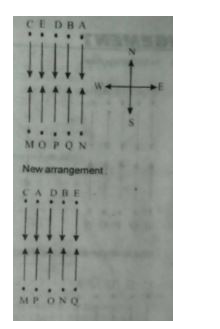Study the following sitting arrangement carefully and answer the given questions.
(1) A,B, C, D and E are five person are sitting in a line facing to South - while M, N, O, P and Q are five ladies sitting in a second line parallel to the first line and are facing to North
(2) B who is just next to the left of D, is opposite to Q.
(3) C and N are diagonally opposite to each other.
(4) E is opposite to o who is just next right of M.
(5) P who is just to the left of Q, is sitting opposite to D.
(6) M is at one end of the line.
If O and P, A and E and N and Q interchange their positions, then who will be the second person to the right of the person who is opposite to the person second of the right of P ?
D
A
E
O
The correct Answer is:B
Topper's Solved these Questions
Similar Questions
In each of the questions given below which one of the following five answer figures on the right should come after the problem figures on the left, if the sequence ware continued?
 02:22View Solution
02:22View SolutionStatement: The civic body put up a huge notice board on the beach located at an isolated part of the city as "Many picknickers died while swimming in the sea during the past few months".
Assumptions:
I. Picknickers may ignore the notice and continue venturing into the sea.
II. Picknickers may read and be careful while venturing into the sea.02:31View SolutionAHNO2−−−→C2H5OH[O]−−→B में A तथा B को पहचान-कर उनके सूत्र एव नाम लिखिए।
07:23View Solutionएक परीक्षा में पास होने वाले तथा पेल होने वालो का अनुपात 3 : 1 था। यदि परीक्षा में 8 विद्यार्थी ज्यादा बैठते तथा 6 कम पास होते तो पास होने तथा फेल होने वालों का अनुपात 2 : 1 है। परीक्षा में कितने विद्याया बेठ थे?
04:17View SolutionA और B एक पाँसे को 1100 रु. के इनाम पर फेंकते हैं जो उस खिलाड़ी द्वारा जीता जाता है जो पहले 6 फेंकता है। यदि A ने पहले पाँसा फेंका, तो उनकी क्रमशः क्या प्रत्याशाएँ हैं?
04:23View Solutionयदि 10 टिकटों पर 1 से 10 तक की (प्रत्येक पर एक) संख्यायें लिखी हुई हैं। कोई संख्या दोहराई नहीं गई है। यदि A एक ऐसी घटना है, जिसमें विषम संख्यायें हों और B एक ऐसी घटना हो, जिसमें 3 से विभाज्य संख्या हों, तो दिखाओ कि P(A∪B)=P(A)+P(B)−P(A∪B)
04:44View Solutionनिम्नलिखित समीकरणों के अनुसार धातु A,B,C,D व H2 की विधुत - रासायनिक श्रेणी का निर्माण करो ।
(i) 2A+2HCl→2ACl+H2
(ii) B+2HCl→BCl2+H2
(iii) 2A+BCl2→2ACl+B
(iv) D+CCl2→DCl2+C
(v) D+HCl→ कोई अभिक्रिया नहीं01:50View Solutionपांच तत्व A, B, C, D व E के E∘ क्रमशः −1.36,+0.32,+1.36,−0.42 तथा −2.2.6 है उनको बढ़ती सक्रियता के क्रम में लिखो ।
06:17View Solutionक्या निम्नलिखित अभिक्रियाएं संभव है ?
(a) Br2(l)+CaI2(aq.)→
(b) Br2(l)+KF(aq.)→03:15View Solutionसमान चालकता सेल में लिए गए दो विलयनों A तथा B के प्रतिरोध क्रमशः 50 ओम तथा 100 ओम है । यदि A व B के सामान आयतन मिला दिए जाये तो सामान चालकता सेल में मिश्रण का प्रतिरोध क्या होगा ?
(मोल A व B को मिलाने पर वियोजन की मात्रा में कोई परिवर्तन नहीं होता है)01:10View Solutionनीचे कुछ अभिक्रियाएँ दी गयी है-
(a) ACl2+B→BCl2+A
(b) B+DCl→ कोई अभिक्रिया नहीं
(c) C+2DCl→2D+CCl2
(d) C+ECl2→ कोई अभिक्रिया नहीं
(e) H2+ECl2→2HCl+E
(f) H2+FCl2→ कोई अभिक्रिया नहीं
उपरोक्त दिए तत्वों (A से F) को रासायनिक सक्रियता के घटते क्रम में व्यवस्थित करो ।View Solutionयदि A और B दो घटनाएँ इस तरह से हों कि P(A)=13,P(B)=14,P(A∩B)=15 तो P(A/B)=
02:54View Solutionनिम्नलिखित कथनों पर विचार करें :
कथन I : यदि A और B प्रतिदर्श समष्टि S के संगत दो घटनाएँ ऐसा है कि P(A)=0.2 और P((B)=0⋅8 तो A⋃B एक सुनिश्चित घटना है |
कथन I : यदि A और B परस्पर अपवर्ती हों तो P(A)+P(B)=1 इन कथनो में :02:18View Solutionयदि l, m, n एक सरल रेखा की दिककोज्याएँ है, तो
02:12View Solutionएक सरल रेखा (2,-1,3) से गुजरती है और इसके दिक्अनुपात 3,-1,2 है | इस रेखा के समीकरण है
02:26View Solutionयदि A तथा B दो स्वतंत्र घटनाएँ हों, तो सिद्ध करें कि P(A∪B)=1−P(A')P.(B')
05:53View Solution


